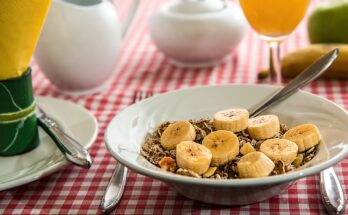Do you ever wonder how the food you eat becomes fortified with essential nutrients? The answer lies in the role of food processing. Food fortification, the process of adding extra nutrients to food, plays a crucial role in addressing nutritional deficiencies and improving public health.
Understanding the various food processing methods involved in fortification is key to ensuring the effectiveness of this vital process. Milling, for example, is a key process that involves grinding grains to produce flour, which is then fortified with vitamins and minerals. Pasteurization, another important step, uses heat to preserve the nutritional value of foods. Extrusion, on the other hand, enhances the efficiency of fortification by creating a uniform distribution of nutrients.
Packaging and storage play a crucial role in maintaining the integrity of fortified foods, while quality control ensures that fortification is effective. By delving into the intricacies of food processing, we can better appreciate the significance of fortifying our food and its impact on our overall health and well-being.
Milling: A Key Process in Food Fortification
Milling is like the superhero that grinds grains into powdery perfection, making it a crucial step in fortifying our food. When you mill grains, you break them down into fine particles, which not only makes them easier to digest but also increases their surface area.
This increased surface area allows for better absorption of essential nutrients during the fortification process. Through milling, the outer layers of the grains, which often contain the most nutrients, are exposed and can be incorporated into fortified products. Moreover, milling helps create a uniform texture, ensuring that the fortified nutrients are evenly distributed throughout the food.
Without milling, fortification would be less effective, as the nutrients would not be as readily available for absorption. So, next time you enjoy a fortified food product, remember the important role that milling plays in making it nutritious and beneficial for your health.
Pasteurization: Preserving Nutrition through Heat
By pasteurizing your food, you can ensure that the nutritional value is preserved through the application of heat. Pasteurization is a key process in food fortification that helps to destroy harmful bacteria and extend the shelf life of food products.
During pasteurization, food is heated to a specific temperature for a set amount of time, killing off pathogens while retaining essential nutrients. This process is commonly used for dairy products, fruit juices, and some canned foods.
By eliminating harmful bacteria, pasteurization helps to reduce the risk of foodborne illnesses and ensures that the food you consume is safe and nutritious. Additionally, pasteurization helps to maintain the quality of food by preventing spoilage and preserving its flavor and texture.
Extrusion: Enhancing Fortification Efficiency
Boost your nutrition intake with extrusion, a process that maximizes fortification efficiency and enhances the nutritional value of your food. Extrusion involves using heat, pressure, and mechanical force to create a continuous flow of food through a specially designed machine. During this process, the food undergoes intense heat and pressure, resulting in changes to its structure and composition.
These changes allow for better nutrient absorption and bioavailability, ensuring that your body gets the most out of the fortified food. Additionally, extrusion can improve the taste, texture, and appearance of the final product, making it more appealing and enjoyable to consume.
By incorporating extrusion into food processing, manufacturers can create fortified products that not only provide essential nutrients but also taste great.
Packaging and Storage: Maintaining Nutrient Integrity
To ensure the nutritional quality of fortified foods, it’s crucial to prioritize proper packaging and storage techniques that preserve the integrity of the nutrients.
When it comes to packaging, choosing materials that are resistant to moisture and oxygen is essential. This helps protect the fortified food from degradation caused by exposure to these elements. Additionally, using packaging that blocks out light can prevent the degradation of certain vitamins that are sensitive to light.
Proper storage conditions also play a vital role in maintaining nutrient integrity. It’s important to store fortified foods in a cool, dry place away from direct sunlight. Avoiding extreme temperatures and humidity can help prevent nutrient loss and maintain the overall quality of the product.
By implementing these packaging and storage techniques, you can ensure that the fortified foods retain their nutritional value and deliver the intended health benefits to consumers.
Quality Control: Ensuring Effective Fortification
Make sure you prioritize quality control measures to ensure the effectiveness of fortification in your products. Quality control is crucial in the food processing industry, especially when it comes to fortification. It involves monitoring and testing the fortified products to ensure that they meet the required nutrient levels and are safe for consumption.

Regular and thorough checks should be conducted at every stage of the production process, from raw material sourcing to final packaging. This includes testing for nutrient content, checking for any contamination or spoilage, and verifying that the fortification process has been carried out correctly.
By implementing robust quality control measures, you can ensure that your fortified products deliver the intended nutritional benefits to consumers, while also meeting regulatory requirements and maintaining the reputation of your brand.
Conclusion
In conclusion, you’ve learned about the important role of food processing in food fortification. Milling plays a key role in breaking down grains and improving nutrient absorption. Pasteurization preserves nutrition by using heat to kill harmful bacteria. Extrusion enhances fortification efficiency by improving the bioavailability of nutrients.
Packaging and storage maintain nutrient integrity, ensuring that fortified foods remain nutritious. Finally, quality control measures are crucial in ensuring that fortification is effective. By understanding these processes, you can appreciate the significance of food processing in creating fortified foods that are both safe and nutritious.




